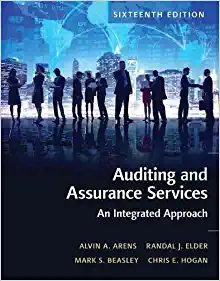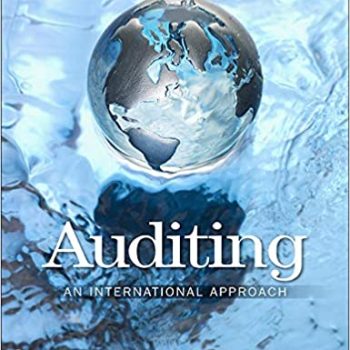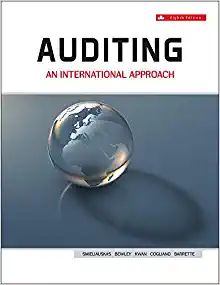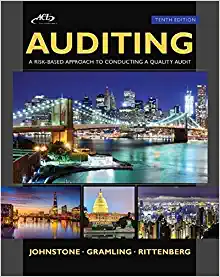Solution Manual For Auditing and Assurance Services An Integrated Approach 16th Edition
ISBN-10 : 0134065824, ISBN-13 : 978-0134065823
Chapter 1: The Demand for Audit and Other Assurance Services
- Concept Checks
- 8
- To do an audit, there must be information in a verifiable form and some standards (criteria) by which the auditor can evaluate the information. Determining the degree of correspondence between information and established criteria is determining whether a given set of information is in accordance with the established criteria. For an audit of a company’s financial statements the criteria are U.S. generally accepted accounting principles or International Financial Reporting Standards.
- The four primary causes of information risk are remoteness of information, biases and motives of the provider, voluminous data, and the existence of complex exchange transactions.
The three main ways to reduce information risk are:
- User verifies the information.
- User shares the information risk with management.
- Audited financial statements are provided.
- 17
- The three main types of audits are operational audits, compliance audits, and financial statement audits. The table below summarizes the purposes and nature of each type of audit.
| OPERATIONAL AUDITS |
COMPLIANCE AUDITS |
AUDITS OF FINANCIAL STATEMENTS |
|
| PURPOSE | To evaluate whether operating procedures are efficient and effective | To determine whether the client is following specific procedures set by a higher authority | To determine whether the overall financial statements are presented in accordance with specified criteria (usually GAAP) |
Concept Checks (continued)
| OPERATIONAL AUDITS |
COMPLIANCE AUDITS |
AUDITS OF FINANCIAL STATEMENTS |
|
| USERS OF AUDIT REPORT | Management of organization | Authority setting down procedures, internal or external | Different groups for different purposes — many outside entities |
| NATURE | Highly nonstandard; often subjective | Not standardized, but specific and usually objective | Highly standardized |
| PERFORMED BY: CPAs |
Frequently | Occasionally | Almost universally |
| GAO AUDITORS |
Frequently | Frequently | Occasionally |
| IRS AUDITORS |
Never | Universally | Never |
| INTERNAL AUDITORS |
Frequently | Frequently | Frequently* |
* Internal auditors may assist CPAs in the audit of financial statements. Internal auditors may also audit internal financial statements for use by management.
- The major differences in the scope of audit responsibilities for CPAs, GAO auditors, IRS agents, and internal auditors are:
- CPAs perform audits of financial statements prepared using S. GAAP or IFRS in accordance with auditing standards.
- GAO auditors perform compliance or operational audits in order to assure the Congress of the expenditure of public funds in accordance with its directives and the law.
- IRS agents perform compliance audits to enforce the federal tax laws as defined by Congress, interpreted by the courts, and regulated by the IRS.
- Internal auditors perform compliance or operational audits in order to assure management or the board of directors that controls and policies are properly and consistently developed, applied, and
- Review Questions
1-1 To do an audit, there must be information in a verifiable form and some standards (criteria) by which the auditor can evaluate the information. The information for Jones Company’s tax return is the federal tax returns filed by the company. The established criteria are found in the Internal Revenue Code and all interpretations. For the audit of Jones Company’s financial statements the information is the financial statements being audited and the established criteria are U.S. GAAP or IFRS.
1-2 This apparent paradox arises from the distinction between the function of auditing and the function of accounting. The accounting function is the recording, classifying, and summarizing of economic events to provide relevant information to decision makers. The rules of accounting are the criteria used by the auditor for evaluating the presentation of economic events for financial statements and he or she must therefore have an understanding of accounting standards, as well as auditing standards. The accountant need not, and frequently does not, understand what auditors do, unless he or she is involved in doing audits, or has been trained as an auditor.1-3 An independent audit is a means of satisfying the need for reliable information on the part of decision makers. Recent changes in accounting and business operations include:
- Increased global activities of many businesses
- Multiple product lines and transaction locations
- Foreign exchange affects transactions
- Complex accounting and exchange transactions
- Increasing use of derivatives and hedging activities
- Increasingly complex accounting standards in areas such as revenue recognition
- More complex information systems
- Possibly millions of transactions processed daily through on-line and traditional sales channels
- Voluminous data requires interpretation







Reviews
There are no reviews yet.